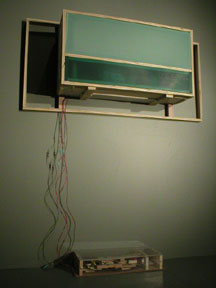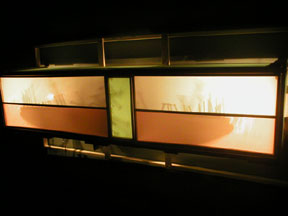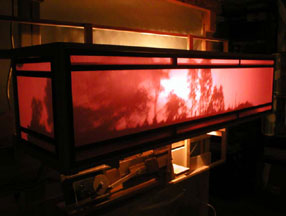If you’re interested at all in the concurrent HC Westermann exhibitions at the CAM and Menil, you’d do well to visit Jeff Shore’s exhibit space, Site Unseen, while his Moving In Stereo is installed.
Adding circuit boards and MP3 players to the tinker-aesthetic equation, Shore and Fisher — like Westermann — examine the relationship between shop kid and storyteller, gadgetry and narrative. The resulting work corrals these two not-quite complementary concerns into objects that have a pleasingly awkward energy. Viewing these objects leaves us with a split admiration: half for the craftsmanship and technical wizardry behind them, and half for the narrative experience they produce.
When you first enter Moving In Stereo, you’re greeted with three wood-and-plastic objects jutting out from three walls of a dark gray room. Basically boxes, each object is attached to the wall by visible wooden supports and looks something like a quickly-assembled prototype for a Donald Judd. Dangling from the objects are umbilical cables attached to smaller Lucite-and-wood boxes, which contain complicated handmade mechanizations. From the ceiling, three spotlights illuminate each of the Moving In Stereo trio. When the installation commences, two of the three spotlights dim, leaving one box lit. An audio track begins to play, and it’s show time.
The show consists of three variations on the same setup. When one box has its turn in the spotlight, it lights up from within, using variously colored party bulbs. Each box contains some kind of moving machine, which when lit by the interior light casts a shadow on the translucent plastic skin of the box. The result is elegantly basic. Like Indonesian puppet theater, or simply making your hand’s shadow look like a bunny, this kind of no-frills special effect has its appeal. That appeal is maintained longer than you’d expect, because none of the boxes are one-trick ponies. Changes in the light and movement in the machines sustain interest and make each shadow show a little performance.
Jon Fisher’s soundtrack is critical to the show. The movements and changes in light are synchronized to sound collages that compliment each piece and transform repetitive actions into a narrative progression. Moving In Stereo 1, which uses screws driven randomly into rotating disks to generate its shadows, is accompanied by a percussive, bubbling soundtrack that makes the endlessly looping screws appear to boil. The second piece in the series looks something like a ground floor and basement in cross section. Mechanized birds flap over the ground floor, animated by pistons that sink through the divide and into the basement, where they’re driven by electric motors. The soundtrack is scraping; part birdlike, part industrial, it mimics the whining of the actual electric motors. The third piece features the shadow of a forest, with alternating headlight-ish lamps and a violent, flashing light that whips around broadly, causing the shadows of the trees to meanacingly swing and change size. This piece’s soundtrack is the most familir of the three: a swelling, synthesized progression that feels lifted from a late night horror movie.
When all three boxes have done their thing, the lights come up. There’s a brief intermission before the routine begins again. The experience is well conceived; although Shore and Fisher have chosen to hide the controlling electronics in a closet, you can sense that there’s a lot of technology happening. Given the homemade quality of the objects, it feels a bit amazing that any of it works, much less that it works to such a high degree of sophistication and synchronicity. This technological prowess is fascinating, and makes it impossible to avoid a Wizard-of-Oz syndrome. Shore’s tour of the closet/master control room was almost as impressive as the installation it automated.
Maybe the most interesting question Moving In Stereo raises is: how much does a story matter? Versus how much does it matter how a story’s being told? Shore’s objects are shadowbox cousins of opera sets and Hollywood movies. The guiding lights and the accompanying soundtracks lead us through his nonspecific tableaux in a meticulously specific way. There’s some kind of narrative at play, but it’s constantly dwarfed by Shore’s Rube Goldberg stunts. In the age of ubiquitous video projectors, there are a dozen simpler ways to throw a shadow onto a plastic sheet. Shore’s virtuoso hi-tech tinkering could undoubtedly produce objects with more discreet mechanics. We know throughout Moving In Stereo that he could make it look easy, so why does he make it look hard? The experience is a bit like watching a special effects film and its “making of” at the same time, with seamlessness competing against the ingenuity that created it. If you’re willing to go along with it, this endless-loop investigation invites you to come to the work like a tinker comes to tinkering: adjusting, tweaking, and not quite sure when to walk away.
David Harrison is a writer and photographer living in Houston.





